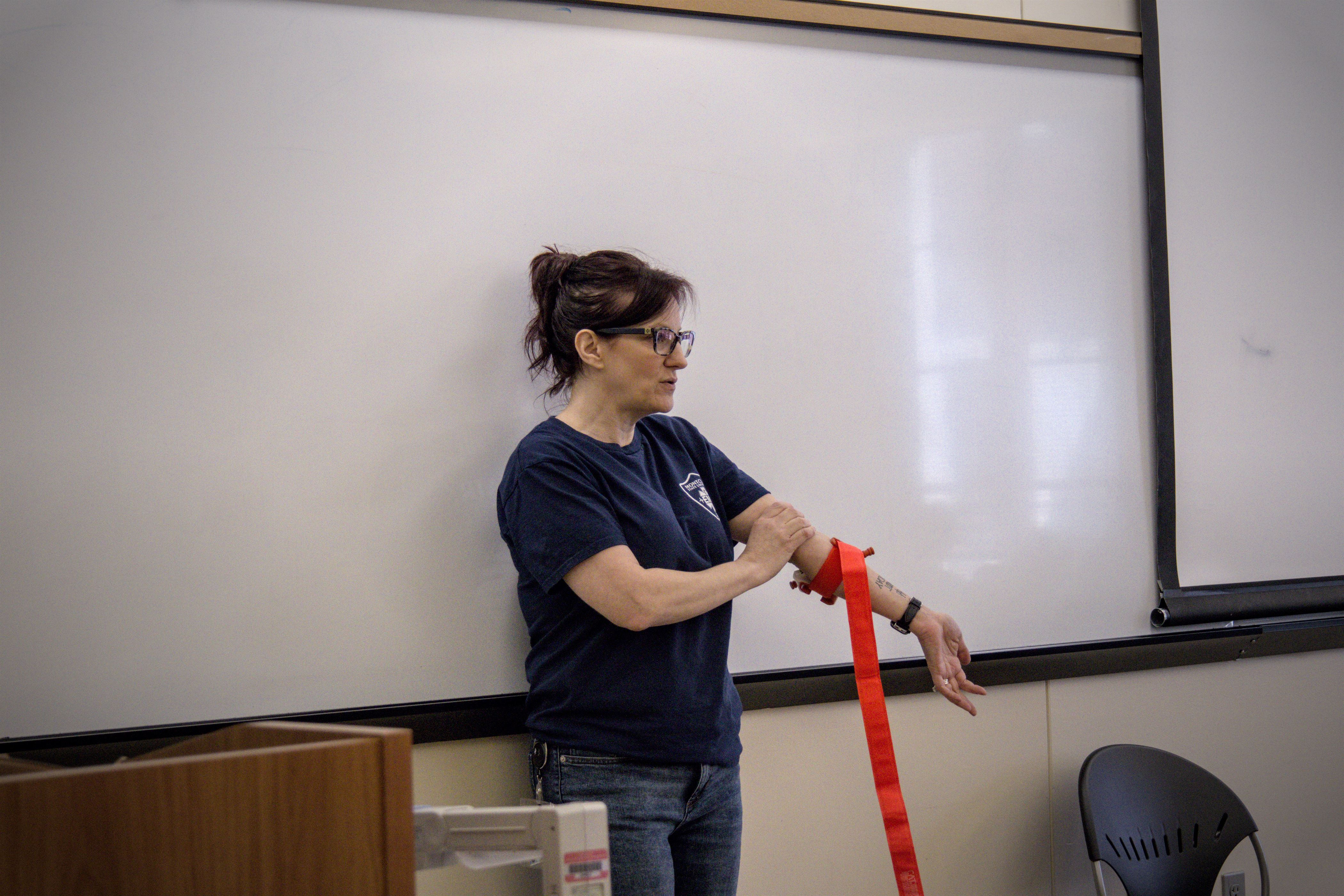As of Sept. 12, 2023, Montclair State University has bleeding control kits installed in Automated External Defibrillator (AED) cabinets around campus.
They are a resource for individuals to use in circumstances where professional medical help cannot arrive at the scene immediately and include instructions for usage. These cabinets are located inside every building, typically on the first floor in an open and visible location.

Michelle Kight, Director of Emergency Medical Services, explains the purpose of bleeding control kits. Allen Macaraeg | The Montclarion
At a demonstration session, Michelle Kight, director of Emergency Medical Services (EMS), explained the purpose of the installation as a precaution.
“EMS installed bleeding control kits in the AED cabinets on campus as part of our commitment to emergency preparedness and just as a precautionary measure,” Kight said.
Kight explained what is included in these kits and provided a demonstration for how each component is used in the event of an emergency.
One example is a tourniquet, which is used to stop or slow bleeding from an arm or leg. There are also Quick Clot gauzes.
“The kits contain essential medical supplies that can be used to control severe bleeding,” Kight said. “The first component is a tourniquet, which can be used to stop bleeding on an arm or leg when direct pressure alone doesn’t work. There is also something called Quick Clot combat gauze which is treated with a hemostatic agent to help an injured area form clots wherever a tourniquet can’t be used.”

Kight demonstrates how to use a tourniquet. Allen Macaraeg | The Montclarion
Kight presented additional equipment included in the kit, including gloves, a survival blanket and trauma dressing.
“So the emergency blanket is there to keep a person warm until help arrives,” Kight said. “We also have something called a trauma dressing. Basically like a giant ACE bandage with some absorbent padding that you could put on a wound and you would put it on just like any kind of ACE bandage and you can pull it pretty tight. So this is a kind of a pressure bandage and again pressure helps to slow bleeding.”
With this addition, students feel more at ease about the fact that they could get immediate medical help in the event of an emergency.
Emily Morales, a senior social media and public relations major, emphasized the importance of the bleeding control kits and knowing how to use them.

Emily Morales, senior public relations and social media major, emphasizes the importance of the bleeding control kits. Allen Macaraeg | The Montclarion
“I have heard of them because I am a building manager at the Student Center,” Morales said. “I think it’s very very important to constantly involve, just as even student leaders, knowing what to do when these things happen.”
Freshman English major, Alondra Munoz, felt positive about this installation and would like for more people to be more informed about this development.

Alondra Munoz, a freshman English major, discusses how the installation benefits the population. Allen Macaraeg | The Montclarion
“I think that’s good, honestly, just have it around,” Munoz said. “Maybe just let more people know about it.”
Vlad Nita, a junior mathematics major, expressed that while he also did not know about the addition of the bleeding control kits, he is reluctant about their effective usage because of his own lack of training.

Vlad Nita, junior math major, thinks that knowing how to use the kits is a valuable skill. Allen Macaraeg | The Montclarion
“So I did not know they [existed] around campus,” Nita said. Personally, I don’t trust myself with stuff like that. I mean, of course, I would like to learn more about them and this definitely seems like something useful.”
Students have an opportunity to be trained on how to use the kits. Kight assured that there are training dates in place to provide students with the skills to use the bleeding control kits all throughout October effectively.
“You can find our classes scheduled on Engage,” Kight said. “We teach CPR regularly and we have also scheduled Narcan and Stop the Bleed training together as one hour-long class. If people are not able to make one of our scheduled classes, they can send us an email or stop by the EMS office and we’d be happy to schedule training.”


